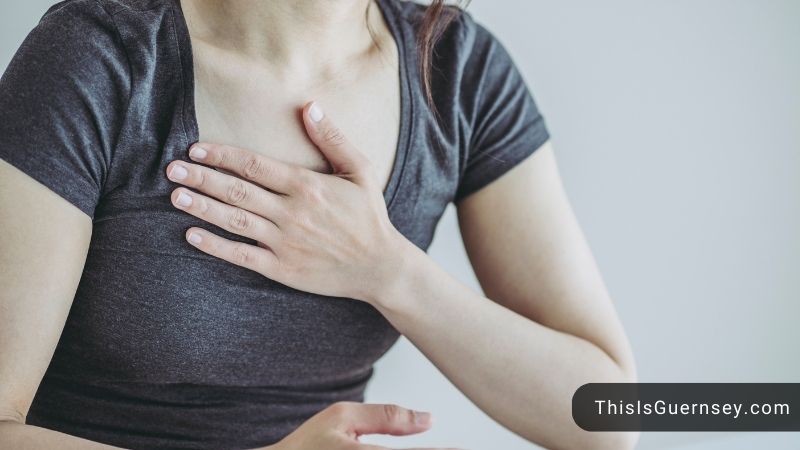The sit-up is one of the most important exercises for the core. As this exercise works on multiple muscles, not just on the abs, it can be used to tone and sculpt the body. However, some people may experience chest pain while doing situps.
In this article, we will discuss the reasons why your chest hurts when doing sit ups. We will also explain how to avoid them and what you should do if you experience them. If you have experienced the same condition and want to know what to do to deal with it, this article is for you!
Why Do I Get Chest Hurts When Doing Sit-Ups/Crunches?
Chest pain is often a sign of heart attack and other related issues. However, if we rule out the heart-related causes, there are also several reasons why your chest hurts when doing sit-ups and sometimes crunches. Let’s take a look at the possible causes below.
Chest wall muscle pain
Sit-up is an exercise requiring the involvement of multiple muscles, including the chest, abdominal, hip, lower back, and neck. Your chest pain would be the result of muscle pain in the chest wall when doing strenuous sit-ups. This has caused your chest wall muscles to experience soreness and pain when moving.
Costochondritis
Costochondritis is the inflammation in the regions where your upper ribs join the cartilage in the middle of your chest (your breastbone). It is also known as costosternal syndrome or chest wall pain syndrome.
This type of inflammation can be caused by a variety of factors. Lifting heavy weights and doing consistent strenuous exercise are often the causes. This condition may make you feel a sharp, aching pain or pressure in your sides. It may worsen if you exercise or move your torso a lot.
This condition is typically harmless and often goes away without needing specialized treatments. If you want to relieve the pain, a warm compress or heating pad at the site of the pain will help.
Increased heart rate, blood pressure & breathing
If you have suffered anxiety or any sign of depression, your heart rate, blood pressure, or breathing may increase. Besides, consuming beverages containing stimulants such as caffeine can also speed up the heart rate and increase blood pressure. These conditions considerably contribute to initiating chest pain.
Heartburn
Weight lifting, sit-ups, ab crunches, some yoga poses, and high-impact workouts can all cause gastroesophageal reflux, leading to heartburn. Heartburn is a sensation caused by the stomach contents forced up into the esophagus due to the increasing pressure on the stomach.
When suffering heartburn, you may feel the fullness or pain just below your ribs, as well as a burning pain that spreads up from your chest to your mouth or neck. You may also experience sourness in your mouth.

What To Do When Getting Chest Pain While Doing Sit-ups?
With those listed causes of chest pain when doing sit-ups, here are some critical things you can do:
- If you get chest pain when doing strenuous exercises such as sit-ups or crunches, you may want to take a break from these strenuous physical activities. If the chest pain is muscle pain, it would resolve after a few days.
- See the specialists or doctors for some medication if this condition happens often, and the chest pain strikes. A topical agent or non-steroidal anti-inflammatory drug (NSAID) usually relieves the symptoms. Moreover, chest pain could be a sign of heart-related issues. So, do not ignore it!
- Start light and low if you are new to workout. You should make sure your sit-up form is correct before increasing the intensity.
- Besides, learning how to breathe correctly is also important if you are a beginner: Exhale when you rise and inhale when you lower.
- You should have short breaks between your sit-up sets. It will give you more time to control your breathing, especially when you are new to workout.
- Remember to drink water. Just take a small sip of water to prevent drainage in your throat.
- Avoid consuming drinks containing caffeine before, during, and after your workout. The stimulants like caffeine may increase your heart rate, blood pressure & breathing when doing strenuous exercises, contributing to chest hurting.
- Avoid eating too full right before your workout. It may induce gastroesophageal reflux when you do sit-ups, causing heartburn and chest hurt.
What Muscles Work During A Sit-up?
A situp is a multi-muscle exercise. The rectus abdominis, or the muscle fibers in front of the torso, are the primary muscles activated during a situp. Other muscles that are worked include the obliques, quadriceps, and hip flexors, which are the muscles that connect your thigh bone to your pelvis.
Briefly, when doing situps, you will work on multiple muscles on your body, including the abdominal (primary), chest (upper abs), quadriceps, hip flexors, lower back, and neck.
Muscle cells have a higher metabolic rate than fat cells, meaning that they burn calories even when they are at rest. Situps will help you burn more calories in the long run by working on multiple muscles, as mentioned.
Is it normal when the chest hurts when doing sit ups?
If you are a beginner in working out and have no history of heart-related health problems, it is normal to get chest pain when doing situps because a situp also works on chest muscles besides the primary abdominal. The pain may go away after a few days.
However, if the pain persists, it’s not normal anymore. You should see and consult the doctor for diagnoses and medication.
Why does my rib cage hurt when I do situps?
If your rib cage hurts when or after you do situps, it’s a muscle cramp that causes abdominal pain or side stitches.
As the muscles that work primarily when doing situps are the rectus abdominis and obliques, you may feel that these muscles expand and constrict during your workout, resulting the pain in the rib cage area.

How do you know if chest pain is muscular or heart-related?
It is difficult to tell the difference between muscular chest pain and heart-related chest pain. However, here are the critical symptoms of each type of chest pain you may want to know.
You may have muscular chest pain if you feel:
- Pain that increases with movement of the chest or upper spine, making it hard to move;
- Pain while breathing deeply, sneezing, or coughing;
- Soreness or tenderness within the chest wall;
- Upper back pain;
- Swelling and bruising.
On the other hand, you may have heart-related chest pain if you experience:
- Pressure, fullness, burning or tightness in your chest;
- Crushing or searing pain that radiates to your back, neck, jaw, shoulders, and one or both arms;
- Pain that lasts more than a few minutes, gets worse with activity, comes and goes repeatedly, or varies in intensity;
- Shortness of breath;
- Cold sweats;
- Dizziness or weakness;
- Nausea or vomiting.
How To Do Sit-ups Properly (To Avoid Chest Pain)?
Having correct form while doing situps can help avoid the strain on the chest. Here are important points you should consider to do situps properly.
- Lie on your back.
- Stabilizing your lower body by bending your legs and placing your feet firmly on the ground.
- Cross your hands across your shoulders or behind your ears without pulling on your neck.
- Curl your upper body upwards toward your knees. As you lift, exhale.
- Slowly lower yourself back to your starting point. As you lower your body, inhale.
- Beginners should do 10 repetitions per set.
FAQs
What are the disadvantages of doing sit-ups?
Doing situps can help you build your body muscle as it works on not only the abdominal but also the quadriceps and hip flexors.
However, the main disadvantage of situps is the risk of lower back and neck injuries. If you’ve had any related injuries, seek medical advice to avoid strain.
Can sit-ups cause stomach issues & affect digestion?
Yes, doing situps could induce stomach/digestion issues, especially in individuals having gastroesophageal reflux disease.
Sit-ups can increase the pressure on your digestive organs, which can lead to intestinal problems like diarrhea and stomachaches. This is particularly common when targeting the lower abdominals. Thus, you should allow for muscle relaxation periods during these types of workouts.
How long does muscular chest pain last?
If your chest strain is mild, it should go away in a few days or weeks. Severe muscular chest pain can take up to two months to heal.
If your chest pain lasts more than twelve weeks, it is considered chronic and could be the result of long-term activities and repetitive motions. In this case, you may want to consult your doctor for some medication to relieve pain.
Video: What Causes Chest Pain After Workout? – Dr. Sanjay Panicker
References:
- https://www.primarycare.theclinics.com/article/S0095-4543(13)00088-2/fulltext
- https://www.verywellhealth.com/chest-wall-pain-1745816
- https://en.wikipedia.org/wiki/Costochondritis
- https://health.clevelandclinic.org/chest-pain-in-young-athletes-when-you-should-be-concerned/
- https://www.mayoclinic.org/diseases-conditions/chest-pain/symptoms-causes/syc-20370838

I’m Renee L. Bazile, and I’m passionate about health and fitness. Keeping fit and active has always been a passion of mine.
I graduated from Nova Southeastern University with a degree in Exercise Science. I believe being healthy and fit is the key to a happy and successful life.
Over the past ten years, I have trained more than 10.000 clients in the fitness industry. My goal is to help others achieve their fitness goals. The saying goes, “If you don’t use it, you lose it.” Therefore, we all need to exercise regularly to maintain health and fitness.
In 2019, I became an expert on health & fitness topics for ThisIsGuernsey after starting my blog about health & fitness. I relax and rebalance my life by walking, fishing, and blogging in my free time.
